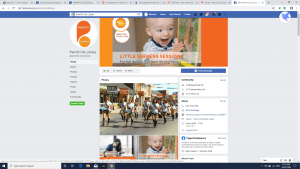OLJ – Evaluation
The evaluation is on the use of social media in the public libraries I am familiar with. How is it adopted and the challenges of using social media in a public library setting (Penrith City Libraries).
Penrith City Library has been taking a proactive approach to apply new technologies in the library services. The library has a Facebook account to promote local events, holiday activities, and library news. It has established a significant collection of e-books, magazines, and audiobooks which patrons can access through apps like Overdrive and Libby. The main branch runs a digital desk to provide technical training mainly targeting senior users. The recent technology added to the library is the RFID where users can borrowing and returning books with ease. The effort of the library adopting social media is also reflected in the catalogue search. Users can share the book through Facebook, Twitter, email. and they can also review the resources available.
Penrith City Library Facebook page.
Web 2.0 signaled a change in which the internet becomes an interactive experience, it encourages two-way or more conversations rather than the traditional one-way conversation. Accordingly, library 2.0 is defined as “a change in the interaction between libraries and library users”. It also refers to “a change towards the increased use of social media” (Huvila et al, 2013, page 198). According to Maness (2006), the theory of library 2.0 should have four essential elements, being user-centred, providing multimedia experience, being socially rich, and being innovative. Penrith City Library’s adoption of new technologies and the involvement of social media are positive. Its practices have been in line with the Library 2.0 principle. However, it still has the potential to expand its existence on social networks. For example, Twitter has been a popular social networking platform used by many libraries, due to its different ways of affecting the aspects and functionalities of libraries. It may be worthwhile for Penrith City Library to explore the other social networking tools beyond Facebook.
Technology is evolving every day. Web 3.0, as the third generation technology upgrade, is about representing meaning, connecting knowledge and bringing these closer together to work in ways to employ intelligent agents, layered applications and interactive systems to provide a productive and intuitive user experience (Balaji et al, 2018). It will be likely that there is a growing diverse use of Web 3.0 in the libraries.
Although the changes in the libraries brought by the technologies and social media are generally positive and exciting, they also create challenges for the libraries.
First of all, the changes brought by Libary 2.0. will have a great impact on the skills and experience required by librarians, which is termed “Librarian 2.0” (Huvila et al, 2013). With the libraries transform in the web 2.0 or 3.0 era, it leads to a change in the professional identity and roles of librarians. New skills and capabilities are required to adapt to the context of the digital age and social media. Professional developments will be essential to help the information professionals to cope with the rapid changes.
A second challenge the library may face is the lack of policy support of Web 2.0. LIbrary policies are guiding documents on the integration of social media and also the conduct on these platforms. A complete formulation of these policies and constant monitoring them are essential to ensure the successful implementation of Web 2.0 tools in public libraries(Jerome et al, 2019).
Next, with the growing services provided through internet and mobile apps, there is a growing privacy threat. Libraries and librarians should follow the ethical framework and take action to protect patron privacy and confidentiality.
Another challenge public libraries need to face is to bridge the digital divide. Despite of significant efforts, digital exclusion is still an international issue. Even among developed countries, there is still a significant difference in the level of skills, Internet use, and uptake of digital services. Therefore, digital exclusion is an important factor that will shape the future activities of public libraries in these countries (Manzuch, 2019). Libraries, especially public libraries, should focus on ways in which they can leverage their provision of technology access with other services and roles to move beyond the access and address broader technological inequalities.
OLJ – Reflection
The study of this subject is a learning journey that changed my view on social media.
My involvement in social media is very limited. Wechat is a social app I used to connect my friends and family overseas. Youtube is the main source for me to learn information. I barely posted any information on social media and haven’t explored other social media tools before the subject. This is mainly due to two considerations. Firstly, privacy concerns – an unintended use of social media is the threat to privacy, including hacking, harassment, identity theft, etc (Heravi et al, 2019). Another concern is the information credibility – the growth of the internet helped the rise of the internet-based media, incorporating voluntary contributions from selected participants and consumers. This leads to information overload (Pentina &Tarafdar, 2014). However, a relative lack of professional gatekeepers to monitor content means that how to evaluate the information credibility an important issue for information users (Li&Suh,2015).
The first benefit of completing the subject is that it expands my understanding of web 2.0 and library 2.0 and the impacts of web 2.0 on libraries. Web 2.0 allows two-way or more ways of communication, and it encourages online collaboration and information sharing. According to Gross (2012), Web 2.0 revolution leads to the transformation of libraries. The core business in the library has evolved from delivering information to creating learning communities. The change of the libraries also demands the change of the librarians. The Librarian 2.0 concept requires that librarians should not be comfortable with being information consumption and collector roles. A competent information professional should embrace technologies and take an active role in the digital context (Huvila, 2013). My attitude of avoiding technology is not a proactive attitude that meets the requirement of the Librarian 2.0. From a personal career perspective, it is compelling to embrace new technologies, as the way librarians find new job opportunities and build their careers has changed because of the Web 2.0 social software(Gross, 2012).
Another change I experienced from completing the subject is my understanding of the digital inclusion issue. Before studying the subject, I used to consider the digital divide as an issue only in developing countries, because of inadequate infrastructures(Lediga & Fombad, 2018). Digital inequality also exists in developed countries and it is not only a result of the lack of physical access but also lack of ICT literacy and skills and psychological or motivational reluctance (Yu et al, 2018). Study shows that 80% of the public library users think that libraries should provide training on digital skills. In addition, there is also a demand for creative technologies like 3-D printers (Comito, 2019). Public libraries play an important role in bridging the gap. Digital inclusion, as the community needs to be created by the emerging technologies, should be one key value that public libraries hold. Public librarians should be proud to convey this value to the communities(Oehlke,2016).
The third change is the understanding of privacy. The popularity and web 2.0 tools mean that information sharing and self-disclosure has never been easier. This also raises the concern of digital privacy- the perception of losing control of one’s personal information, with possible secondary use by other parties(Elhai, 2017). However, avoiding social media is not the best solution to ease privacy concerns. Ensuring digital information security is essential for public libraries to provide the best user experience while maintaining the public trust(Burton,2019). However, studies show that although librarians understand the necessity to keep privacy safe, they are not fully aware of the different forms privacy violations might take (Kim & Noh, 2014). Accessing social media does not have to come with the price of loss of privacy. Librarians must extend the traditional privacy doctrines to social media platforms (Lamdan, 2015).
Reference
Balaji, B., M.S., V., B.G., S. and J.S., M. (2018), “An integrative review of Web 3.0 in academic libraries”, Library Hi Tech News, 35 (4), pp. 13-17. https://doi-org.ezproxy.csu.edu.au/10.1108/LHTN-12-2017-0092
Burton, A. (2019). How the new york public library guards privacy in the digital age. Dow Jones Institutional News. https://doi.org/10.1002/asi.20530
Comito, L. (2019). Tech for all : moving beyond the digital divide. Retrieved from https://ebookcentral.proquest.com/lib/csuau/detail.action?docID=5646157#
Elhai, J., Levine, J. and Hall, B. (2017), “Anxiety about electronic data hacking: Predictors and relations with digital privacy protection behavior”, Internet Research, 27(3), 631-649. https://doi-org.ezproxy.csu.edu.au/10.1108/IntR-03-2016-0070
Gross, J.(2012). Web 2.0 and your library career. In
J. Gross (Eds.), Building Your Library Career with Web 2.0,
(pp. 1-13). Chandos Publishing. https://doi.org/10.1016/B978-1-84334-651-7.50001-7.
Heravi,A., Mubarak, S., Choo, K.R. (2018). Information privacy in online social networks: Uses and gratification perspective. Computers in Human Behavior, 84, 441-459. https://doi.org/10.1016/j.chb.2018.03.016.
Huvila, I., Holmberg, K., Kronqvist-Berg, M., Nivakoski, O., & Widén, G. (2013). What is Librarian 2.0 – New competencies or interactive relations? A library professional viewpoint. Journal of Librarianship and Information Science, 45(3), 198–205. https://doi.org/10.1177/0961000613477122
Jerome, I., Foluke, O., Ayooluwa, A., Sola, O., Toluwani, E., & Felicia, Y. (2019). Application of web 2.0 technology in library and information centres in developing countries: Challenges and way forward. Library Philosophy and Practice, 5, 1-9. Retrieved from https://search-proquest-com.ezproxy.csu.edu.au/docview/2236692768?accountid=10344
Kim, D.S., & Noh, Y. (2014). A Study of Public Library Patrons’ Understanding of Library Records and Data Privacy. International Journal of Knowledge Content Development & Technology, 4(1), 53–78. https://doi.org/10.5865/IJKCT.2014.4.1.053
KINNEY, B. (2010).The Internet, Public Libraries, and the Digital Divide. Public Library Quarterly, 29(2), 104–161. DOI 10.1080/01616841003779718.
Kritikos, K.C., Zimmer, M. (2017). Privacy Policies and Practices with Cloud-Based Services in Public Libraries. Journal of intellectual freedom & privacy, 2(1). Retrieved from https://www.journals.ala.org/index.php/jifp/article/view/6252/8394
LEDIGA, M. M.; FOMBAD, M. C. (2018). The use of information and communication technologies in public libraries in South Africa as tools for bridging the digital divide: the case of the Kempton Park public library. Public Library Quarterly, 37(3), 296–305. DOI 10.1080/01616846.2018.1471964.
Lamdan, S. (2015). Social Media Privacy: A Rallying Cry to Librarians. The Library Quarterly: Information, Community, Policy, 85(3), 261-277. doi:10.1086/681610
Li, R. & Suh, A. (2015). Factors Influencing Information credibility on Social Media Platforms: Evidence from Facebook Pages. Procedia Computer Science. 72, 314-328. 10.1016/j.procs.2015.12.146.
Maness, J. (2006). Library 2.0 Theory: Web 2.0 and Its Implications for Libraries. Webology, 3(2).
Retrieved from: http://www.webology.org/2006/v3n2/a25.html
Manžuch, Z, Macevičiūtė, E. (2019). Getting ready to reduce the digital divide: scenarios of Lithuanian public libraries. Journal of the Association for Information Science and Technology, 1– 13. https://doi-org.ezproxy.csu.edu.au/10.1002/asi.24324
Oehlke, V. (2016). Libraries lead effort to bridge the digital divide. Public Libraries, 55, 5-6. Retrieved from https://search-proquest-com.ezproxy.csu.edu.au/docview/1778692806?accountid=10344
Pentina, I., Tarafdar, M. (2014). From “information” to “knowing”: Exploring the role of social media in contemporary news consumption. Computers in Human Behavior,35. 211-223. https://doi.org/10.1016/j.chb.2014.02.045.
Yu, B., Ndumu, A., Mo, L.M., Fan, Z. (2018). “E-inclusion or digital divide: an integrated model of digital inequality.” Journal of Documentation 74(3): 552-574. https://doi-org.ezproxy.csu.edu.au/10.1108/JD-10-2017-0148

